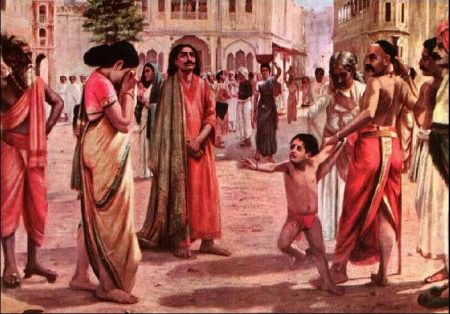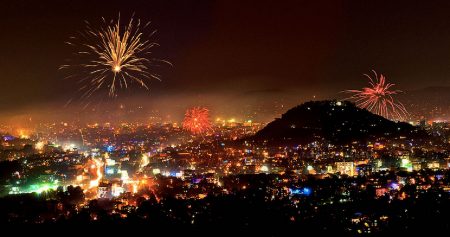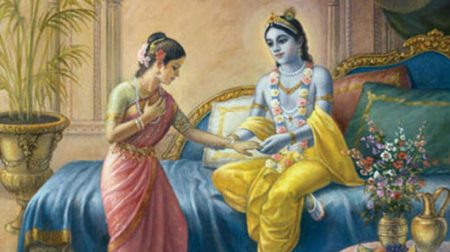Why is Basant Panchami or Vasant Panchami celebrated? Stories related to Basant Panchami | Why people wear yellow clothes on Basant Panchami?
Basant Panchami or Vasant Panchami is a Hindu festival that is considered to be the starting of the spring season in India.
Basant means “Spring” and Panchami means “fifth day”. That’s why it is celebrated as the onset of the spring season in India on the fifth day of the lunar month “Magha” of the ancient Hindu calendar.
According to the Gregorian calendar, it usually falls in the month of January or February.
In 2024, Basant Panchami falls on 14th February

Why people wear yellow clothes on Basant Panchami?
In this season, the agricultural field is filled with yellow flowers of mustard (सरसों) crop. Yellow color further symbolizes light, energy, optimism, and prosperity. Therefore people usually wear yellow colored clothes on this day.
According to many astrologers, the day of Basant Panchami is considered to be “Abhujh” (अबूझ). It means that this day is auspicious (शुभ मुहूर्त) for doing any kind of good work all day long.
Foundation of Education:
This day is considered auspicious to begin a child’s education. Traditionally, people lay the foundation of the education of their children on this day. Children are taught their first words on this day.
Also Read: The Eight Types of Marriages (Vivah) in Hinduism
Table of Contents
Why is Basant Panchami celebrated?
There are many reasons for celebrating Basant Panchami.
1. Saraswati Puja:

Many Hindus celebrate Basant Panchami to pay reverence (श्रद्धा) to goddess Saraswati. Goddess Saraswati is the deity of knowledge, wisdom, language, art, and music.
Meaning of Saraswati – Saraswati, also spelled as Sarasvati is made up of two Sanskrit words: Sara (सार) and Sva (स्व). “Sara” means essence and “Sva” means oneself. Thus Saraswati means “one who leads to the essence of self-knowledge.”
Hence, people dress up statues of Goddess Saraswati in yellow-colored clothes in temples and worship them. Many schools and colleges arrange special prayers in the morning to seek the blessing of the goddess Saraswati.
SARASWATI VANDANA (HYMN):
या कुंदेंदु तुषारहार धवला,या शुभ्र वस्त्रावृता |
या वीणावर दण्डमंडितकरा,या श्वेतपद्मासना ||
या ब्रह्माच्युतशंकरप्रभ्रृतिभिर्देवै: सदा वन्दिता |
सा मां पातु सरस्वती भगवती निःशेष जाड्यापहा ||
शुक्लां ब्रह्मविचार सार परमां आद्यां जगद्व्यापिनीं |
वीणा पुस्तक धारिणीं अभयदां जाड्यान्धाकारापाहां |
हस्ते स्फाटिक मालीकां विदधतीं पद्मासने संस्थितां |
वन्दे तां परमेश्वरीं भगवतीं बुद्धि प्रदां शारदां ||
ENGLISH TRANSLATION:
May Goddess Saraswati,
who is fair like the jasmine-colored moon,
and whose pure white garland is like frosty dew drops;
who is adorned in radiant white attire,
on whose beautiful arm rests the Veena,
and whose throne is a white lotus;
who is surrounded and respected by the Gods, protect me.
May you fully remove my lethargy, sluggishness, and ignorance.
2. Kamdev and Rati (her consort):
In some places in India, this day is also celebrated in the reverence of Kamdev or Kamadev, the deity of love and desires. There are many popular stories related to this.

According to one popular belief, on this day Parvati (consort of Shiva) approached Kamdev to help her in waking up Shiva from Yogic Samadhi.
Kamdev shoots the arrow of love at Lord Shiva to break his meditation.
Meaning of Samadhi – Samadhi means a state of deep meditative contemplation which leads to higher consciousness.

Another popular belief is that Kamdev was burnt to ashes by Lord Shiva when he tries to wake him up from his Samadhi. His (Kamdev’s) wife Rati, did ardent penance (तपस्या) of Lord Shiva. Due to this, on the day of Basant Panchami, Kamdev was brought back to life by Lord Shiva.
Also Read: 7 Reasons – Why Mahashivaratri is celebrated?
3. Kite Flying Festival
In regions like Punjab, people celebrate Basant Panchami by flying kites. This kite-flying festival is known as the Basant Festival of Kites.

Likewise, kite flying is extremely popular in the northern and western regions of India like Rajasthan, Gujarat, Maharashtra, Uttar Pradesh, etc.

During the 19th century, the founder of the Sikh Empire, Maharaja Ranjit Singh held an annual Basant fair on Basant Panchami in the Gurudwara. Furthermore, he also introduces a tradition of kite flying on Basant Panchami.
If you have something to add to this article or you find something wrong in this article or just wanted to share your thoughts, just write them down in the comment section below.
And don’t forget to share this article with your friends and family & let them know the significance of celebrating Basant Panchami.
Read More:







